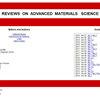考虑二阶粗糙度的节理粗糙系数形态学分类方法及数据驱动估计
IF 3.6
4区 材料科学
Q2 MATERIALS SCIENCE, MULTIDISCIPLINARY
引用次数: 0
摘要
节理面粗糙度是评价岩石抗剪强度的重要指标。天然节理的波状度(一阶)和凹凸度(二阶)对节理表面粗糙度的表征有不同的影响。为了准确量化二阶粗糙度对结合面轮廓曲线的结合粗糙度系数(JRC)预测的影响,通过改变结合面轮廓曲线的R p {R}_{{\rm{p}}}值来确定最优的粗糙度采样间隔。以最优采样间隔完成48条节理面轮廓曲线的二阶粗糙度的分离,并从轮廓曲线的粗糙角、粗糙度和轨迹长度三个方面对粗糙度的形态学参数i ave {i}_{{\rm{ave}}}、R max {R}_{{\rm{\max}}、R p {R}_{{\rm{p}}}进行计数。基于形态学参数的统计结果,考虑了二阶粗糙性,提出了新的非线性预测模型。结果表明:曲线斜率突变点SI = 2 mm为节理面轮廓曲线二阶凹凸度的最佳分离距离;考虑形态参数的波浪性和不均匀性的精细化分离方法可以在更多维度上表征节理表面的详细形态特征。考虑了二阶粗糙度分离结果的支持向量回归(SVR)和随机森林(RF)模型比传统模型具有更高的精度。与SVR(SO)和RF(SO)模型相比,SVR模型的预测精度提高了7-8%。考虑两阶节理表面粗糙度分离的SVR非线性模型更适合于JRC的预测。本文章由计算机程序翻译,如有差异,请以英文原文为准。
Morphological classification method and data-driven estimation of the joint roughness coefficient by consideration of two-order asperity
Abstract The roughness of the joint surface plays a significant role in evaluating the shear strength of rock. The waviness (first-order) and unevenness (second-order) of natural joints have different effects on the characterization of joint surface roughness. To accurately quantify the influence of the two-order asperity on the joint roughness coefficient (JRC) prediction of joint surface profile curve, the optimal sampling interval of the asperity was determined through the change of the R p {R}_{{\rm{p}}} value of the joint surface profile curve. The separation of the two-order asperity of 48 joint surface profile curves was completed at the optimal sampling interval, and morphological parameters of the asperity such as i ave {i}_{{\rm{ave}}} , R max {R}_{{\rm{\max }}} , and R p {R}_{{\rm{p}}} were counted from three aspects: asperity angle of the profile curve, asperity degree, and the trace length. Based on the statistical results of the morphological parameters considering the two-order asperity, the new nonlinear prediction models were proposed. The results showed that the curve slope mutation point SI = 2 mm is the optimal separation distance of the two-order asperity of the joint surface profile curve. The refined separation method that considers the waviness and unevenness of morphological parameters can characterize the detailed morphological features of the joint surface in more dimensions. The support vector regression (SVR) and random forest (RF) models that take into account a two-order asperity separated results have higher accuracy than traditional models. The prediction accuracy has improved by 7–8% in SVR model compared with SVR(SO) and RF(SO). The SVR nonlinear model that considering separation of two-orders of joint surface roughness is more suitable for the prediction of JRC.
求助全文
通过发布文献求助,成功后即可免费获取论文全文。
去求助
来源期刊

Reviews on Advanced Materials Science
工程技术-材料科学:综合
CiteScore
5.10
自引率
11.10%
发文量
43
审稿时长
3.5 months
期刊介绍:
Reviews on Advanced Materials Science is a fully peer-reviewed, open access, electronic journal that publishes significant, original and relevant works in the area of theoretical and experimental studies of advanced materials. The journal provides the readers with free, instant, and permanent access to all content worldwide; and the authors with extensive promotion of published articles, long-time preservation, language-correction services, no space constraints and immediate publication.
Reviews on Advanced Materials Science is listed inter alia by Clarivate Analytics (formerly Thomson Reuters) - Current Contents/Physical, Chemical, and Earth Sciences (CC/PC&ES), JCR and SCIE. Our standard policy requires each paper to be reviewed by at least two Referees and the peer-review process is single-blind.
 求助内容:
求助内容: 应助结果提醒方式:
应助结果提醒方式:


